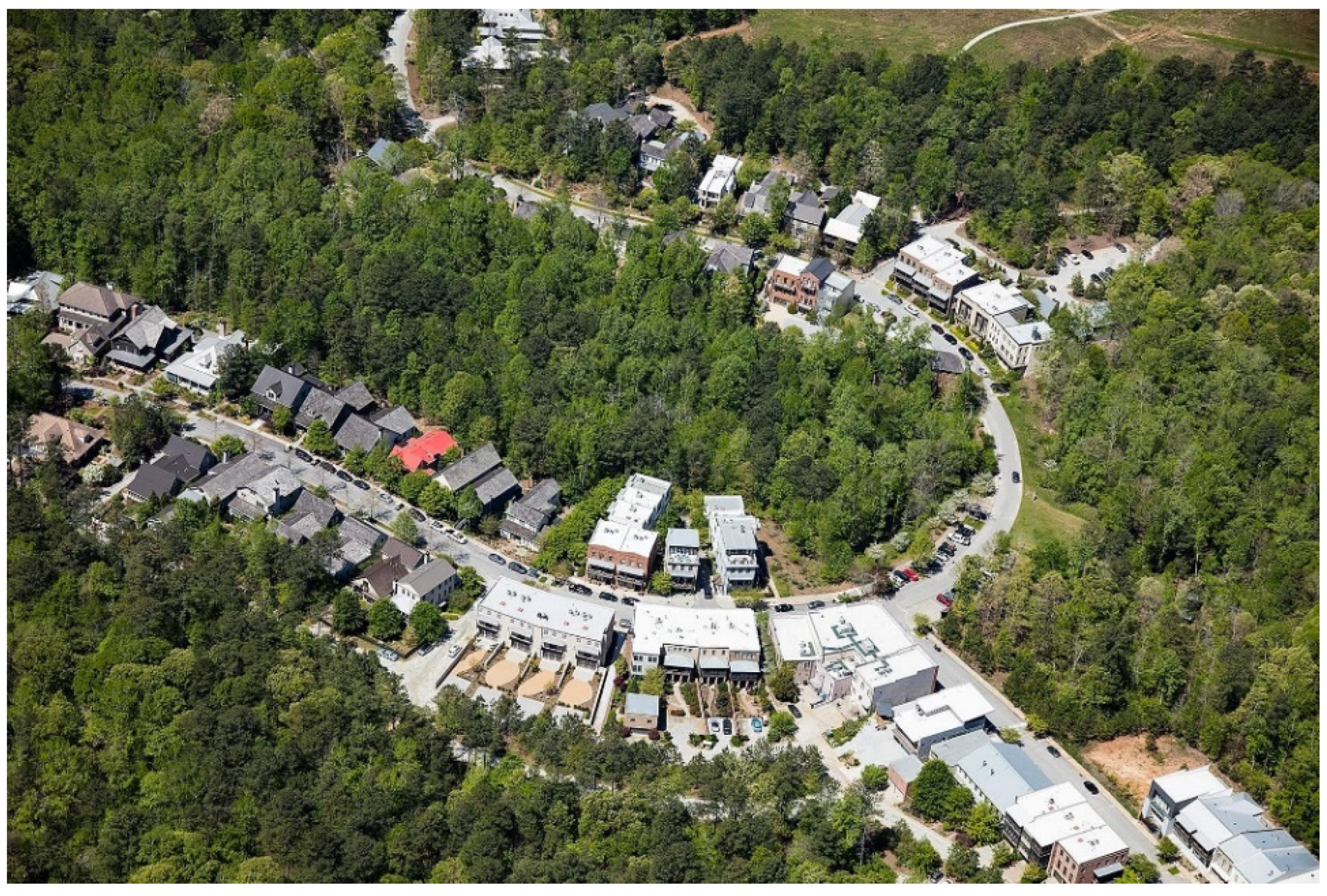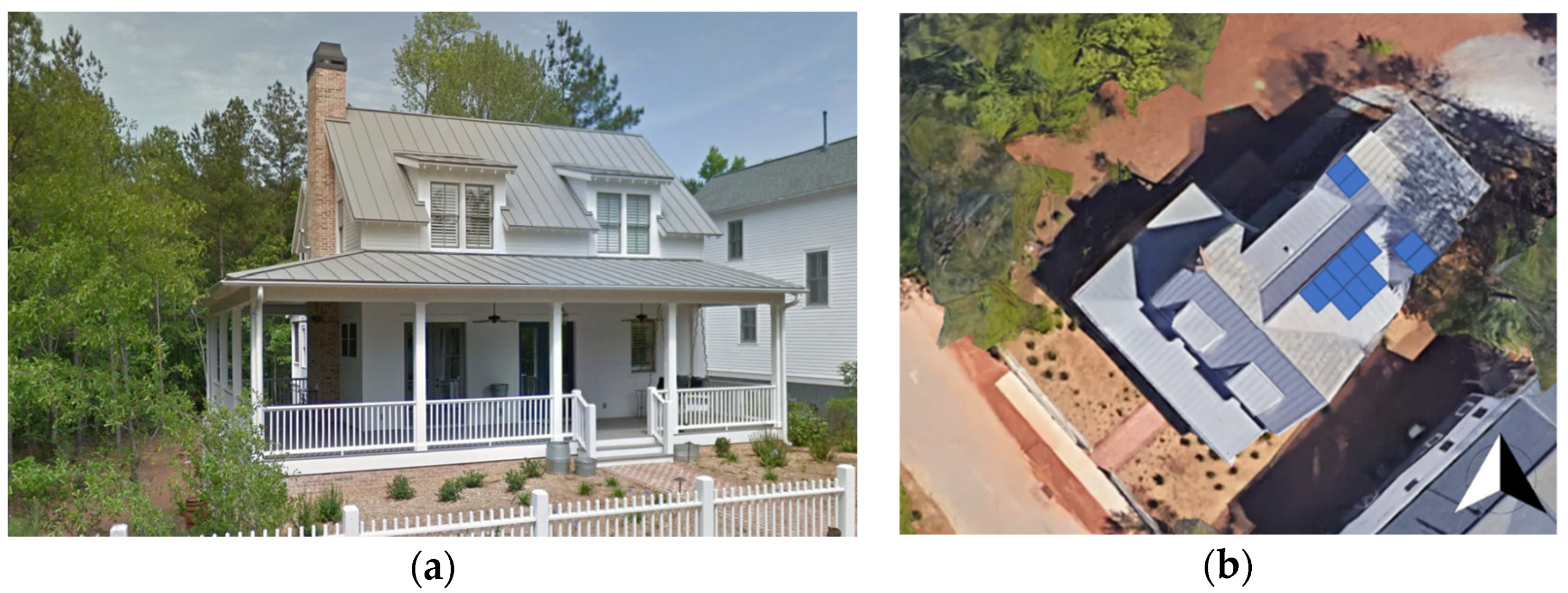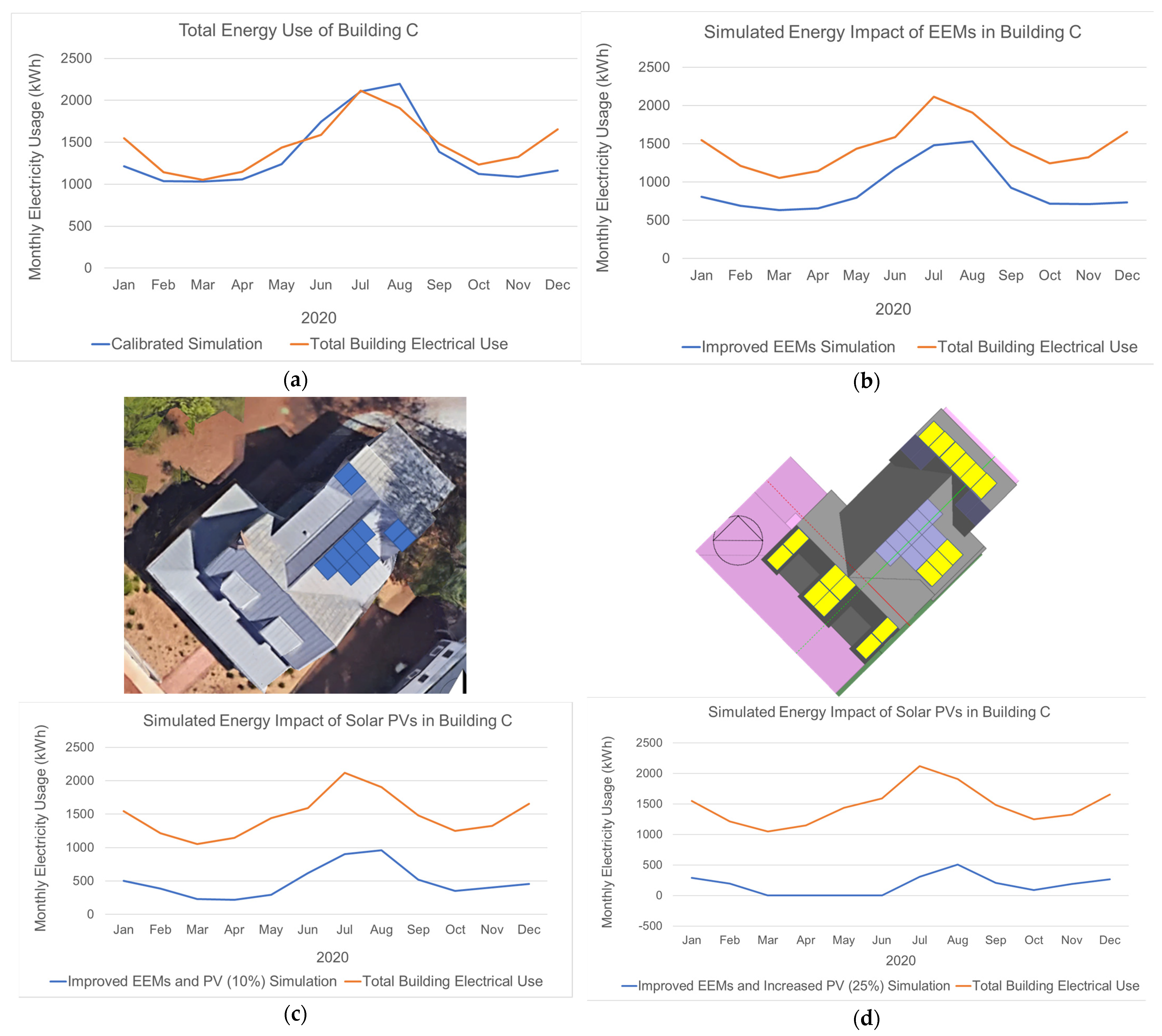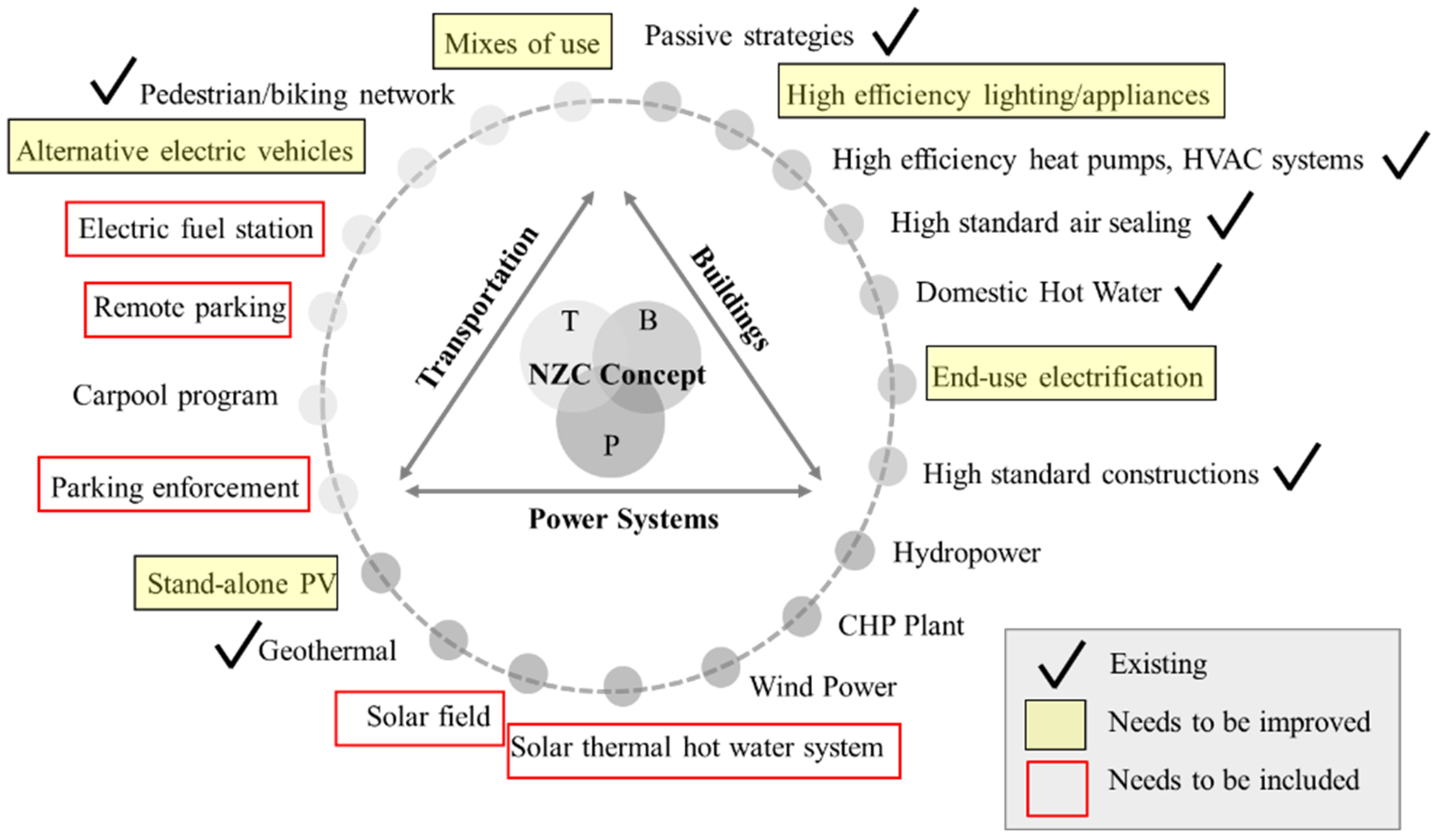An Adaptable Net Zero Model: Energy Analysis of a Monitored Case Study
Abstract
:1. Introduction
- An adaptable net zero model;
- A comparative energy analysis of a monitored building’s total electrical use versus two (2) simulated models (improved EEMs and improved EEMs plus increased PV);
- A comparative energy analysis of a monitored community’s total electrical use versus two (2) simulated models (improved EEMs and improved EEMs plus increased PV);
- A comparative analysis of the community solar field versus rooftop PV systems in regard to the design limitations and installation cost.
2. Proposed Model
3. Monitored Case Study
4. Methodology
- Nest Cottage, by DOE in 2012;
- DOE Zero Energy Ready Home, by DOE in 2014;
- A typical (average-size) single-family building in Serenbe, by the authors in 2020,
- Baseline: total building electrical use (measured electricity data plus PV generation);
- Simulated models: calibrated base case; improved EEMs; improved EEMs plus increased PV.
4.1. Building A: Nest Cottage by DOE (2012)
4.2. Building B: Zero Energy Ready Home by DOE (2014)
4.3. Building C: Typical Building in the Serenbe Community (2020)
4.3.1. Measured Data plus Produced Solar PV (Base Case)
4.3.2. Improved EEM Simulations
4.4. Optimization Variables
4.4.1. Lighting
4.4.2. Window Glazing
4.4.3. Air Sealing
4.4.4. HVAC Systems
4.5. Results from Energy Analysis of Building C
4.6. Community Energy Analysis
5. Community Solar and Economic Analysis
6. Results and Discussion
NZCX%(ORG) Projections in Serenbe 2020
- Providing solutions that reduce trip distances.
- ○
- integration of mixes of use daily requirements (i.e., groceries, cultural center, library).
- Encouraging pedestrian movement.
- ○
- comprehensive path system and sidewalks;
- ○
- remote parking lots for the gasoline-powered vehicles at the site boundary;
- ○
- parking enforcement.
- Promoting alternative electric vehicles.
- ○
- solar-powered charging stations in individual buildings;
- ○
- electric fuel stations;
- ○
- autonomous electric shuttles [55].
7. Conclusions
Author Contributions
Funding
Acknowledgments
Conflicts of Interest
Nomenclature
| ACH50 | air changes per hour at 50 Pascals pressure |
| AIA | American Institute of Architects |
| BA | Building America |
| CHP | combined heat and power plant |
| CFIS | central fan integrated supply |
| CFL | compact fluorescent lamp |
| COP | coefficient of performance |
| DGS | Department of General Services |
| DOE | Department of Energy |
| EEMs | energy efficiency measures |
| EER | energy efficiency ratio |
| EF | energy factor |
| EIA | Energy Information Administration |
| EPA | Environmental Protection Agency |
| EPBD | European Performance of Buildings Directive |
| ERV | energy recovery ventilator |
| EU | European Union |
| GHG | greenhouse gas |
| GSHP | ground source heat pump |
| HRV | heat recovery ventilator |
| HVAC | heating, ventilation, and air conditioning |
| IEA | International Energy Agency |
| IECC | International Energy Code Council |
| IESNA | Illumination Engineering Society of North America |
| ILFI | International Living Future Institute |
| IPCC | Intergovernmental Panel on Climate Change |
| LED | light-emitting diode |
| NBI | New Buildings Institute |
| NCTH | new construction test house |
| NREL | National Renewable Energy Laboratory |
| NZ | net zero energy |
| NZB/NZEB/ZNEB/ZEB/NZE/ZE | net zero energy building |
| NZC | net zero energy community |
| NZE2050 | net zero CO2 emissions by 2050 |
| PV | photovoltaic |
| RE | renewable energy |
| REHVA | Federation of European Ventilation and Air-Conditioning Associations |
| SEER | seasonal energy efficiency ratio |
| SHGC | solar heat gain coefficients |
| SIR | savings to investment ratio |
| TMY | typical meterological year |
| UNEP | United Nations Environment Programme |
| USGBC | Green Building Council |
| WMO | World Meterologial Organization |
References
- The Intergovernmental Panel on Climate Change (IPCC). Available online: https://www.ipcc.ch/about/history/ (accessed on 14 March 2021).
- Pischke, E.C.; Solomon, B.D.; Wellstead, A.M. A historical analysis of US climate change policy in the Pan-American context. J. Environ. Stud. Sci. 2018, 8, 225–232. [Google Scholar] [CrossRef]
- United Nations Framework Convention on Climate Change (UNFCCC). Available online: https://unfccc.int/process-and-meetings/the-paris-agreement/the-paris-agreement/key-aspects-of-the-paris-agreement (accessed on 14 March 2021).
- US Environmental Protection Agency (EPA). FACT SHEET: Overview of the Clean Power Plan. Available online: https://archive.epa.gov/epa/cleanpowerplan/fact-sheet-overview-clean-power-plan.html (accessed on 22 December 2021).
- Newburger, E. Biden Pledges to Slash Greenhouse Gas Emissions in Half by 2030. Available online: https://www.cnbc.com/amp/2021/04/22/biden-pledges-to-slash-greenhouse-gas-emissions-in-half-by-2030.html (accessed on 22 April 2021).
- Teske, S. Achieving the Paris Climate Agreement Goals: Global and Regional 100% Renewable Energy Scenarios with Non-Energy GHG Pathways For+ 1.5 C And+ 2 C; Springer Nature: Berlin/Heidelberg, Germany, 2019. [Google Scholar]
- Sun, Y.; Huang, P.; Huang, G. A multi-criteria system design optimization for net zero energy buildings under uncertainties. Energy Build. 2015, 97, 196–204. [Google Scholar] [CrossRef]
- Aelenei, L.; Gonçalves, H. From Solar Building Design to Net Zero Energy Buildings: Performance Insights of an Office Building. Energy Procedia. 2014, 48, 1236–1243. [Google Scholar] [CrossRef] [Green Version]
- Gupta, S.; Smith, J. Research Gap Analysis for Zero-Net Energy Buildings: Final Project Report. Available online: https://ww2.energy.ca.gov/2019publications/CEC-500-2019-031/CEC-500-2019-031.pdf (accessed on 3 February 2021).
- Lucon, O.; Vorsatz, D.; Ahmed, A.Z.; Akbari, H.; Bertoldi, P.; Cabeza, L.; Eyre, N.; Gadgil, A.; Harvey, D.; Jiang, Y.; et al. Mitigation of Climate Change: Contribution of Working Group III to the Fifth Assessment Report of the Intergovernmental Panel on Climate Change; Cambridge University Press: Cambridge, UK; New York, NY, USA, 2014. [Google Scholar]
- International Energy Agency and United Nations Environment Programme (UNEP). Global Status Report towards a Zero-Emission, Efficient and Resilient Buildings and Construction Sector. Available online: http://hdl.handle.net/20.500.11822/27140 (accessed on 2 February 2021).
- International Energy Agency (IEA). Net Zero by 2050: A Roadmap for the Global Energy Sector. Available online: https://iea.blob.core.windows.net/assets/4482cac7-edd6-4c03-b6a2-8e79792d16d9/NetZeroby2050-ARoadmapfortheGlobalEnergySector.pdf (accessed on 30 May 2021).
- Clean Energy States Alliance. 100% Clean Energy Collaborative–Table of 100% Clean Energy States. Available online: https://www.cesa.org/projects/100-clean-energy-collaborative/guide/table-of-100-clean-energy-states/ (accessed on 30 August 2021).
- Moghaddasi, H.; Culp, C.; Vanegas, J.; Ehsani, M. Net Zero Energy Buildings: Variations, Clarifications, and Requirements in Response to the Paris Agreement. Energies 2021, 14, 3760. [Google Scholar] [CrossRef]
- Moghaddasi, H.; Culp, C.; Vanegas, J. Net Zero Energy Communities: Integrated Power System, Building and Transport Sectors. Energies 2021, 14, 7065. [Google Scholar] [CrossRef]
- Wells, L.; Rismanchi, B.; Aye, L. A review of Net Zero Energy Buildings with reflections on the Australian context. Energy Build. 2018, 158, 616–628. [Google Scholar] [CrossRef]
- Wei, W.; Skye, H.M. Residential net-zero energy buildings: Review and perspective. Renew. Sustain. Energy Rev. 2021, 142, 110859. [Google Scholar] [CrossRef]
- Economidou, M.; Todeschi, V.; Bertoldi, P.; D′Agostino, D.; Zangheria, P.; Castellazzia, L. Review of 50 years of EU energy efficiency policies for buildings. Energy Build. 2020, 225, 110322. [Google Scholar] [CrossRef]
- Bertoldi, P.; Economidou, M. EU Member States Energy Efficiency Policies for the Industrial Sector Based on the NEEAPs Analysis. 2018, pp. 117–127. Available online: https://www.eceee.org/library/conference_proceedings/eceee_Industrial_Summer_Study/2018/1-policies-and-programmes-to-drive-transformation/eu-member-states-energy-efficiency-policies-for-the-industrial-sector-based-on-the-neeaps-analysis/ (accessed on 26 May 2022).
- Fournier, E.D.; Cudd, R.; Federico, F.; Pincetl, S. Implications of the timing of residential natural gas use for appliance electrification efforts. Environ. Res. Lett. 2020, 15, 124008. [Google Scholar] [CrossRef]
- Wills, A.D.; Beausoleil-Morrison, I.; Ugursal, V.I. A modelling approach and a case study to answer the question: What does it take to retrofit a community to net-zero energy? J. Build. Eng. 2021, 40, 102296. [Google Scholar] [CrossRef]
- Kelly, N.; Cowie, A.; Flett, G. Assessing the ability of electrified domestic heating in the UK to provide unplanned, short-term responsive demand. Energy Build. 2021, 252, 111430. [Google Scholar] [CrossRef]
- Zhang, X.; Wang, A.; Tian, Z.; Li, Y.; Zhu, S.; Shi, X.; Jin, X.; Zhou, X.; Wei, S. Methodology for developing economically efficient strategies for net zero energy buildings: A case study of a prototype building in the Yangtze River Delta, China. J. Clean. Prod. 2021, 320, 128849. [Google Scholar] [CrossRef]
- Ceglia, F.; Esposito, P.; Marrasso, E.; Sasso, M. From smart energy community to smart energy municipalities: Literature review, agendas and pathways. J. Clean. Prod. 2020, 254, 120118. [Google Scholar] [CrossRef]
- Estrella Guillen, E.; Samuelson, H.W.; Vohringer, C. The impact of cultural assumptions on simulated energy, comfort, and investment returns of design decisions in two desert climates. Build. Simul. 2021, 14, 931–944. [Google Scholar] [CrossRef]
- ASHRAE. About ASHRAE. Available online: https://www.ashrae.org/about (accessed on 16 May 2022).
- Chen, Y.; Hong, T.; Piette, M.A. Automatic generation and simulation of urban building energy models based on city datasets for city-scale building retrofit analysis. Appl. Energy 2017, 205, 323–335. [Google Scholar] [CrossRef] [Green Version]
- Klein, S.J.; Coffey, S. Building a sustainable energy future, one community at a time. Renew. Sustain. Energy Rev. 2016, 60, 867–880. [Google Scholar] [CrossRef] [Green Version]
- Dorotić, H.; Doračić, B.; Dobravec, V.; Pukšec, T.; Goran, K.; Neven, D. Integration of transport and energy sectors in island communities with 100% intermittent renewable energy sources. Renew. Sustain. Energy Rev. 2019, 99, 109–124. [Google Scholar] [CrossRef]
- Kumar, R.R.; Alok, K. Adoption of electric vehicle: A literature review and prospects for sustainability. J. Clean. Prod. 2020, 253, 119911. [Google Scholar] [CrossRef]
- Nygren, S.; Moghaddasi, H.; Culp, C. Serenbe Community. Available online: http://www.zoom.com (accessed on 25 August 2021).
- Tabb, P.J. Biophilic Urbanism: Designing Resilient Communities for the Future; Routledge: Oxfordshire, UK, 2020. [Google Scholar] [CrossRef]
- Moghaddasi, H.; Tabb, P.; Rashed-Ali, H. What it Takes to Become a Net Zero Development: Case Study of Serenbe, Georgia. Prometheus Journal. Chicago, IL (Unit-ed States). Available online: https://www.researchgate.net/publication/344478020 (accessed on 10 December 2020).
- EarthCraft. EarthCraft House. Available online: https://earthcraft.org/programs/earthcraft-house/ (accessed on 24 August 2021).
- Department of Energy (DOE). Building America Zero Energy Ready Home Case Study: Imery Group, Proud Green Home, Serenbe GA. Available online: https://www.energy.gov/eere/buildings/downloads/building-america-zero-energy-ready-home-case-study-imery-group-proud-green (accessed on 22 December 2021).
- Butler, T.; Curtis, O.; Kim, E.; Roberts, S.; Stephenson, R. Serenbe Nest Cottages, National Renewable Energy Lab (NREL). Available online: https://www.nrel.gov/docs/fy13osti/54889.pdf (accessed on 22 December 2021).
- Department of Energy (DOE). Estimating Costs and Efficiency of Storage, Demand, and Heat Pump Water Heaters. Available online: https://www.energy.gov/energysaver/estimating-costs-and-efficiency-storage-demand-and-heat-pump-water-heaters (accessed on 22 December 2021).
- ENERGYSTAR. Water Heater Key Product Criteria. Available online: https://www.energystar.gov/products/water_heaters/residential_water_heaters_key_product_criteria (accessed on 22 December 2021).
- Department of Energy (DOE). Storage Water Heaters. Available online: https://www.energy.gov/energysaver/storage-water-heaters (accessed on 22 December 2021).
- ENERGY STAR. Available online: https://www.energystar.gov/ia/partners/bldrs_lenders_raters/downloads/National_Program_Requirements.pdf (accessed on 22 December 2021).
- Panasonic Corporation. Harbor Smart Battery™. Available online: https://www.solaris-shop.com/content/Panasonic%20Pika%20Specs.pdf (accessed on 30 December 2021).
- Haleh, M.; Charles, C.; (Texas A&M University, College Station, TX, USA); Juliet, C.; (Serenbe’s resident, GA, USA). Personal communications, 2019–2021.
- ENERGY STAR. ENERGY STAR Most Efficient 2021–Geothermal Heat Pumps. Available online: https://www.energystar.gov/products/energy_star_most_efficient_2020/geothermal_heat_pumps (accessed on 23 December 2021).
- Department of Energy (DOE). LED Lighting. Available online: https://www.energy.gov/energysaver/led-lighting (accessed on 29 January 2022).
- International Energy Agency (IEA). Tracking Heat Pumps. Available online: https://www.iea.org/reports/tracking-heat-pumps-2020 (accessed on 23 December 2021).
- Feldman, D.; Brockway, A.M.; Ulrich, E.; Margolis, R. Shared Solar. Current Landscape, Market. Potential, and the Impact of Federal Securities Regulation; National Renewable Energy Lab. (NREL): Denver, CO, USA, 2015. [Google Scholar]
- Das, S.; Wilson, E.; Williams, E. The impact of behavioral and geographic heterogeneity on residential-sector carbon abatement costs. Energy Build. 2020, 231, 110611. [Google Scholar] [CrossRef]
- Melius, J.; Margolis, R.; Ong, S. Estimating Rooftop Suitability For PV: A Review of Methods, Patents, and Validation Techniques; National Renewable Energy Lab. (NREL): Denver, CO, USA, 2013. [Google Scholar]
- Feldman, D.; Ramasamy, V.; Fu, R.; Ramdas, A.; Jal, D.; Robert, M.U.S. Solar Photovoltaic System and Energy Storage Cost Benchmark: Q1 2020; National Renewable Energy Laboratory: Denver, CO, USA, 2021. [Google Scholar]
- Sengupta, M.; Xie, Y.; Lopez, A.; Habte, A.; Galen, M.; James, S. The national solar radiation data base (NSRDB). Renew. Sustain. Energy Rev. 2018, 89, 51–60. [Google Scholar] [CrossRef]
- National Renewable Energy Laboratory (NREL). Solar Resource Data, Tools, and Maps. Available online: https://www.nrel.gov/gis/solar.html. (accessed on 26 May 2022).
- Solar Electric Supply. Q CELLS Q.PEAK DUO L-G5.3 390 390W Solar Panel. Available online: https://www.solarelectricsupply.com/q-peak-duo-l-g5-3-390w-q-cells-solar-panel (accessed on 26 May 2022).
- U.S. Department of Energy (DOE). Cost-Effectiveness of ANSI/ASHRAE/IES Standard 90.1-2019 for Georgia. Available online: https://www.energycodes.gov/sites/default/files/2021-07/Cost-effectiveness_of_ASHRAE_Standard_90-1-2019-Georgia.pdf (accessed on 20 March 2022).
- United States Environmental Protection Agency (EPA). Green Vehicle Guide. Available online: https://www.epa.gov/greenvehicles/greenhouse-gas-emissions-typical-passenger-vehicle#:~:text=typical%20passenger%20vehicle%3F-,A%20typical%20passenger%20vehicle%20emits%20about%204.6%20metric%20tons%20of,8%2C887%20grams%20of%20CO2 (accessed on 26 May 2022).
- Hou, F.; Chen, X.; Chen, X.; Yang, F.; Ma, Z.; Zhang, S.; Liu, C.; Zhao, Y.; Guo, F. Comprehensive analysis method of determining global long-term GHG mitigation potential of passenger battery electric vehicles. J. Clean. Prod. 2021, 289, 125137. [Google Scholar] [CrossRef]













| States | Net Zero Goal | Year | Status |
|---|---|---|---|
| Arizona | 100% carbon-free electricity | 2070 | Order |
| California | 100% carbon-free electricity | 2045 | Legislation |
| Colorado | 100% carbon-free electricity | 2050 | Law |
| Connecticut | 100% carbon-free electricity | 2040 | Order |
| District of Columbia | 100% renewable energy | 2032 | Law |
| Hawaii | 100% renewable energy | 2045 | Legislation |
| Louisiana | Net zero greenhouse gas emissions | 2050 | Order |
| Maine | 100% clean energy | 2050 | Legislation |
| Massachusetts | Net zero greenhouse gas emissions | 2050 | Order |
| Michigan | Economy-wide carbon neutrality | 2050 | Legislation |
| Nevada | 100% carbon-free electricity | 2050 | Order |
| New Jersey | 100% carbon-free electricity | 2050 | Order |
| New Mexico | 100% carbon-free electricity | 2045 | Legislation |
| New York | 100% carbon-free electricity | 2040 | Legislation |
| Oregon | Greenhouse gas emissions reduced 100% below baseline emissions | 2040 | Legislation |
| Puerto Rico | 100% renewable energy | 2050 | Legislation |
| Rhode Island | 100% renewable energy | 2030 | Order |
| Virginia | 100% carbon-free electricity | 2045–2050 | Law |
| Washington | 100% zero-emissions electricity | 2045 | Law |
| Wisconsin | 100% carbon-free electricity | 2050 | Order |
| Reference | Def. and Requirements | Methods and Metrics | Tracking Progress | Identified NZ Limitations |
|---|---|---|---|---|
| Moghaddasi et al. [14,15] | 🗸 | 🗸 | 🗸 | A lack of a common international concept and standardized method to quantify, track, and verify NZ |
| Wells et al. [16] | 🗸 | NZ uncertainty; energy demand unpredictability | ||
| Wei and Skye [17] | 🗸 | 🗸 | A lack of data on recent progress in residential NZ buildings | |
| Economidou et al. [18,19] | 🗸 | Insufficient existing policies to promote energy efficiency in buildings | ||
| Fournier et al. [20] | 🗸 | 🗸 | A lack of published measured data on buildings’ energy use; unavailability of high temporal resolution natural gas consumption data | |
| Will et al. [21] | 🗸 | 🗸 | A lack of common understanding and definition; detailed energy model simulation of energy retrofits and community-scale renewable generation systems | |
| Kelly et al. [22] | 🗸 | A need for a clear route to decarbonize domestic heat to switch from gas boilers to heat pumps | ||
| Zhang et al. [23] | 🗸 | 🗸 | 🗸 | A lack of common definition/requirements, economically efficient strategies, and measured data. |
| Ceglia et al. [24] | 🗸 | 🗸 | A need for scientific data on smart energy community adaptation and control strategies to meet energy demand. | |
| Guillen et al. [25] | 🗸 | A lack of accuracy in energy modeling tools |
| Organizations | On-Site/Off-Site Renewable Supply | Source Energy | Site Energy | |
|---|---|---|---|---|
| U.S. Green Building Council | USGBC | Both | • | |
| Illumination Engineering Society of North America | IESNA | Both | • | |
| New Buildings Institute | NBI | Both | • | |
| ASHRAE * | Both | • | ||
| American Institute of Architects | AIA | Both | • | |
| Environmental Protection Agency | EPA | On-site | • | |
| International Living Future Institute | ILFL | On-site | • | |
| European Performance of Buildings Directive | EPBD | On-site | • | |
| Fed. of European Ventilation and Air-conditioning | REHVA | On-site | • | |
| Department of Energy | DOE | On-site | • | |
| Department of General Services | DGS | On-site | • | |
| Measures | Nest Cottage |
|---|---|
| Foundation | Basement |
| Foundation insulation | R-10 (exterior drainage mat) |
| Wall construction | 2 × 6 |
| Wall insulation | R-20 (open cell spray foam) |
| Ceiling construction | Cathedral attic |
| Ceiling insulation | R-26 (open cell spray foam) |
| Window ratings | U-0.35, SHGC-0.31 |
| Infiltration | ACH50 ≤ 5 |
| Heating efficiency | 5.5 COP at full load and 6.3 COP at part load |
| Cooling efficiency | 16 EER at full load and 18.6 EER at part load a |
| Ventilation | Central fan integrated supply b that meet ASHRAE 62.2 ventilation rates when outside air ventilation is used |
| Hot water efficiency | 0.67 EF c, gas storage water heater |
| Lighting | 20% incandescent, 80% CFL |
| Appliances | ENERGY STAR |
| Measures | Building B |
|---|---|
| Wall insulation | Above-grade, 2 × 6 advanced frame R-20 open cell spray foam plus R-6.6 rigid foam, fiber cement, and corrugated siding |
| Roof insulation | ENERGY STAR 24-gauge aluminum standing seam metal roof R-32 open cell spray foam plus R-5 rigid foam, sealed attic |
| Window ratings | Coated aluminum clad, dual pane, low-E, U-0.29, SHGC-0.20 |
| Infiltration | 0.21 ACH50 a |
| HVAC system Heating efficiency Cooling efficiency | Mini-split heat pump with 1 exterior unit, 3 interior units ducted to rooms 8.20 HSPF (2.40 COP) b 14.30 SEER (12.51 EER) b |
| Ventilation | 90% efficient energy/heat recovery ventilators (ERV) |
| Hot water efficiency | Solar thermal, with 80-gallon tank and electric backup, 0.95 efficient |
| Lighting | 63% LED and 32% CFL, with lighting controls |
| Appliances | ENERGY STAR |
| Building Characteristics |  |
|---|---|
| Site | Atlanta, GA, climate zone IECC 3A (mixed-humid) |
| Construction year | Completed 2016 |
| Total area | 228 m2 (2454 SF) |
| Type/stories | Single family, 2 stories and 1 basement |
| Zones | 3—basement, main floor, upper floor |
| Wall construction | 2 × 6 |
| Wall insulation | R-19 (open cell spray foam) |
| Ceiling construction | Cathedral attic |
| Ceiling insulation | R-30 (open cell spray foam) underside the attic |
| EEMs | Base Case | Improved EEMs |
|---|---|---|
| 33 LED (50%) and 33 incandescent recessed lighting (50%) | LED with linear control (100%) |
| Normalized power density (W/m2-100 lux) a | 7.5 | 3.5 |
| Double Low E (e2 = 0.1) Clear 3mm/13mm Air | SageGlass Climatop Grey No Tint |
| Solar heat gain coefficient (SHGC) | 0.60 | 0.27 |
| U-Value (W/m2-K) | 1.8 | 0.7 |
| 0.7 | 0.2 |
| GSHP, water source heat pump SM036-1VTC | Same as the one used in the base case |
| Heating efficiency | 4 COP (13.7 HSPF) [43] | |
| Cooling efficiency | 26 EER (30 SEER) [43] | |
| Hot water efficiency | Domestic with gas storage water heater |
| Scenarios | Electricity Use (kWh) | Percentage of Electric Power Covered by PV (NZ) | Utility Energy Savings Compared to the Baseline |
|---|---|---|---|
| Baseline: Utility electricity use and PV | 17,641 | 26% | __ |
| 1—Improved EEMs and existing PV (10%) simulation | 10,789 | 46% | 65% |
| 2—Improved EEMs and increased PV (25%) simulation | 10,769 | 80% | 88% |
| Buildings in Serenbe Community (Detached Single-Family) | Construction Completed | Year of Analysis | Area (m2) | PV (kW) | Calculation Tools | Result | Type of Analysis |
|---|---|---|---|---|---|---|---|
| A—Nest Cottages | 2011 | 2012 | 157 (1690 SF) | __ | Building Energy Optimization (BEopt) | Met the goal of 30% above the BA benchmark. | Calculated method. |
| B—DOE Zero Energy Ready Home | 2013 | 2014 | 261 (2800 SF) | 10 | __ | -60% less energy use compared to a similar building with the 2009 IECC. -Home Energy Rating System (HERS) Index of -10, NZ home. | Measured utility data. |
| C—Building C | 2016 | 2021 | 228 (2454 SF) | 4.7 | DesignBuilder v7 EnergyPlus 9.4 | 34% energy savings with improved EEMs. 88% savings with increased solar PV on the roof. | Comparative analysis of the measured baseline data with simulated models. |
| Number of Dwellings | Average Area of Solar PV (Hectare) | Annual Electricity Generations (GWh) | Annual Electricity Savings ($) | Annual CO2 Savings (Tonnes) |
|---|---|---|---|---|
| 600 (2020) | 3.5 (9acre) | 5 | ≈522 k | 3.8 k |
| 1800 (eventual) | 10.4 (30acre) | 16 | ≈1.6 million | 11.5 k |
| Percentage of Buildings with Rooftop PV (25%) in a Community of 1800 Buildings | Average Area of the Solar Field (Hectare) | Total Area of the Solar Panel (Hectare) | Cost | Total Installation Cost (Million USD) | |
|---|---|---|---|---|---|
| PV on the Roof (Million USD) | Solar Field (Million USD) | ||||
| (1) 100% | - | 10.44 (30 acres) | 11.8 | - | 11.8 |
| (2) 50% | 5 (13 acres) | 5.9 | 3.7 | 9.6 | |
| (3) 20% | 8 (20 acres) | 2.4 | 6 | 8.3 | |
Publisher’s Note: MDPI stays neutral with regard to jurisdictional claims in published maps and institutional affiliations. |
© 2022 by the authors. Licensee MDPI, Basel, Switzerland. This article is an open access article distributed under the terms and conditions of the Creative Commons Attribution (CC BY) license (https://creativecommons.org/licenses/by/4.0/).
Share and Cite
Moghaddasi, H.; Culp, C.; Vanegas, J.; Das, S.; Ehsani, M. An Adaptable Net Zero Model: Energy Analysis of a Monitored Case Study. Energies 2022, 15, 4016. https://doi.org/10.3390/en15114016
Moghaddasi H, Culp C, Vanegas J, Das S, Ehsani M. An Adaptable Net Zero Model: Energy Analysis of a Monitored Case Study. Energies. 2022; 15(11):4016. https://doi.org/10.3390/en15114016
Chicago/Turabian StyleMoghaddasi, Haleh, Charles Culp, Jorge Vanegas, Saptarshi Das, and Mehrdad Ehsani. 2022. "An Adaptable Net Zero Model: Energy Analysis of a Monitored Case Study" Energies 15, no. 11: 4016. https://doi.org/10.3390/en15114016
APA StyleMoghaddasi, H., Culp, C., Vanegas, J., Das, S., & Ehsani, M. (2022). An Adaptable Net Zero Model: Energy Analysis of a Monitored Case Study. Energies, 15(11), 4016. https://doi.org/10.3390/en15114016







